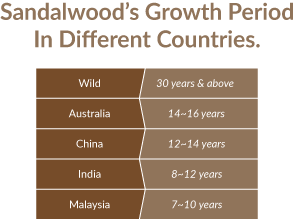Growing Conditions
Sandalwood trees grow slowly, and usually do not reach maturity until several decades later.
In the growing process, whether they grow fast or slow, good or bad, it is largely related to the soil, terrain, climate, host plant and care. Here are some of the criteria that promote the ideal growth of sandalwood plants:
1.Temperature/Climate
2.Wind Conditions
3.Suitable Site with Plenty of Sunshine and Efficient Water Irrigation
4.Sufficient Water Supply
5.Soil Condition
6.Seed and Host Plant Selection Techniques
7.Plantation Management Knowledge
Usage
From the highest point of its leaves to the lowest depth of its roots, every part of sandalwood can be processed and turned into useful products. Sandalwood tree can grow up to 5-12m and the wood is often used for carving, handicraft and fine furniture. Its inner heartwood is rich in oils that are highly aromatic, which are then processed for fragrance and other commercial uses. Sandalwood leaves can be processed into high quality sandalwood tea leaves that give away a more unique aroma and taste. Sandalwood bud is a very precious medicinal material, which was initially recorded in the Shen Nong's Herbal Classic. Sandalwood chips can be grounded into flours which exudes a fragrant, deep and long-lasting scent.
Economic Value of Sandalwood
For more than one hundred years, the transaction prices of sandalwood trees have been rising. More recently, its prices continue to climb steadily at an annual rate of 10%. However, that also clearly shows that sandalwood production has been far behind the market demand. Sandalwood represents quality life. As people are increasingly craving for exclusivity, everyone aspires for living an elegant and comfortable lifestyle. Therefore, incense culture begins to catch on in today's society. As the highest-grade consumer goods in the incense culture, sandalwood is bound to become more and more popular.
Future of Sandalwood
The demand for sandalwood is predicted to experience steady growth year by year as more discoveries continue to expand its applications for various fields such as pharmaceuticals and fragrance. Its great economic rise is also contributed by major investments from international institutions worldwide, a trend we foresee to continue for years to come.
For instance, TFS Corporation Ltd. (TFS) recently announced that its joint venture with Santalis Pharmaceuticals had result in a licenced deal with a global pharmaceutical company for various dermatological products.
Even Harvard University in Cambridge, Massachusetts has invested an estimated million in a 399-hectare plantation set up and run by Tropical Forestry Services (TFS). This investment by a world renowned education institution marked a huge step forward for sandalwood industry, boosting both its credibility and credence.






